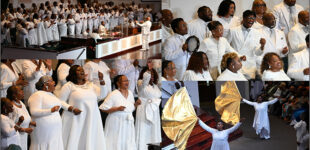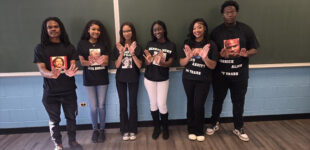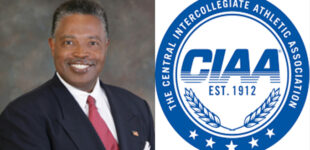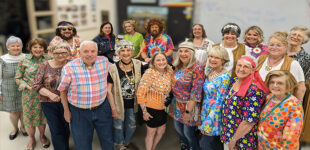The whitewashing of Atkins High School
Editorial Cartoon by Ron Rogers
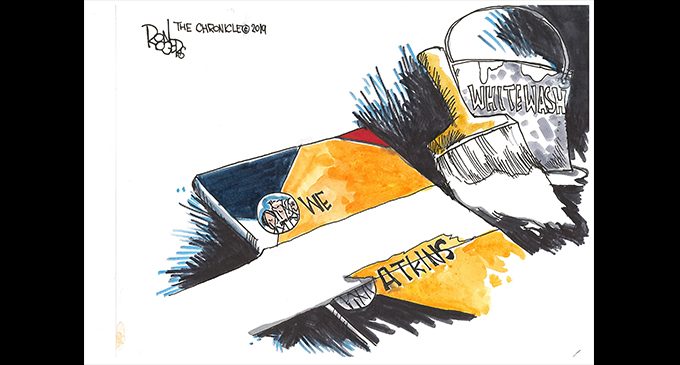
Before I begin, let me just say as a 2009 graduate of Simon G. Atkins Academic and Technology High School, no one is more proud of the academic success the school has experienced over the past few years. According to the U.S. News & World Report, Atkins is ranked No. 1 among high schools in the county and 57th in the state. The students, faculty and staff should be applauded for what they’ve done to turn things around at the school.
But I digress.
Built in 1931 and named after longtime educator Dr. Simon Green Atkins, the original Atkins High School was part of The Rosenwald Fund, which was established by Sears Roebuck co-owner Julius Rosenwald to support the construction of schools to educate African Americans. The construction of the school on Cameron Avenue (now Winston-Salem Preparatory Academy) marked the first use of the Rosenwald Fund in the state and was the first school in Winston-Salem built to serve African Americans.
While preparing students for college, Atkins also offered courses like printing, building trades, sewing and millinery for students who intended to go right into the workforce. With a caring faculty and staff and family-like atmosphere, Atkins quickly became known as a hub of black excellence. Those who remember the days of the old Atkins, including Mayor Pro Tempore Burke, often talk about the sense of pride that exuded throughout the building.
Notable alumni include: Togo West Jr., former Secretary of the U.S. Army and Secretary of Veterans Affairs; Larry Womble, former member of N.C. House of Representatives; William Bell, former Mayor of Durham; Nadine Winter, former District of Columbia Council Member; Lawrence Joel, U.S. Army Veteran and recipient of the Medal of Honor; and current Winston-Salem City Council Member Annette Scippio, to name a few.
After closing its doors as a high school in the early 1970s, the building served as the home of Atkins Middle School until the early 2000s, around the same time district officials started having conversations about building two new high schools, one in East Winston and another in the Northern part of the county. Thanks to the Bill & Melinda Gates Foundation and their partnership with the state, called N.C. New Schools Project, the high school in East Winston came to life and when it came time to name the school, the Board of Education voted unanimously to name the school Atkins.
About a year before the school was scheduled to open, Daniel Piggott, who served as principal at Atkins, and other administrators went on a recruiting tour, visiting inner city middle schools and talking to rising high school freshmen about the opportunities Atkins had to offer. As a student at Atkins Middle School at the time, I remember vividly being called into the library to hear about the legacy of the old Atkins and how the new school would continue the legacy of educating and molding the future leaders in our community.
When Simon G. Atkins Academic and Technology High School opened its doors in 2005, it only housed ninth and tenth graders. Most of the students who attended the first few years were bused to the school from neighborhoods in the East and Southeast portions of the city, which created a student body that was nearly 90% minority students. And because it was a magnet and residential school, students could also attend Atkins from other parts of the city.
As I noted earlier, I graduated from Atkins and I was there in 2005 when the school officially opened, so I saw firsthand how the plan to house three schools under one roof never really developed. Initially, incoming students had the opportunity to choose between three different schools or focus areas: Biotechnology, Computer Technology, and Pre-Engineering. While it looked good on paper, most students never really learned much about jobs and opportunities in the focus area they chose.
In fact, I can count on one hand how many courses I took related to the Computer Technology, the school I chose as a freshman.
By 2007 most people thought Atkins was the worse school in the district. And failing test scores, constant violence, dropping enrollment and scandals that were reported by every major news outlet in the area didn’t help prove otherwise. Just two years after the school opened its doors, talks began about closing the school.
I’ll admit in the early years Atkins had its issues, but they weren’t things that couldn’t have been fixed. Although most people saw the bad things that were happening at the school, no one reported on the relationships and bonds that were being built between teachers and students.
By the time the first group of seniors were set to graduate in 2008, you could see the school finally taking shape. There were less fights, test scores were improving, and students were starting to take pride in being Camels. Despite being labeled as “bad students” who went to an even worse school, the Class of 2008 and the Class of 2009 produced business owners, business managers, public relations specialists, doctors, chemists, graphic designers, and military personnel.
The success of the first two graduating classes alone proved that things were turning around at Atkins. But when Joe Childers was named principal in 2010, he vowed to make some changes and although he didn’t say it, that virtually meant changing the make-up of the student body.
One of the first changes Childers made was dropping the three schools. He then made the school a STEM magnet and dropped the residential requirement, which made it harder for students of to get in and pushed out all the students from the East and Southeast Wards.
By 2011, the same students from the inner city who were persuaded to attend the school less than 10 years earlier, were no longer welcomed. After dropping the residential requirement, enrollment dropped to 274 students. Since that time, the school has seen a steady increase of students each year from more affluent parts of the city and county. Today only 56% of the students are minorities.
We Are Atkins? Really?
While this topic has been on my mind for some time, an email to The Chronicle from a concerned parent prompted me to put pen to pad and share my thoughts. The concerns from the parent stemmed from the design of the 2019 yearbook.
Aside from being the worst design I’ve ever seen, the cover of the yearbook shows three pictures of Caucasian students (who I assume go to the school) with the lettering “WE ARE ATKINS” in bold print. The parent said when she logged online to order the yearbook, she was taken aback by the cover.
She said, “I wondered how Winston-Salem’s first modern high school for African Americans, an integral part of the Big 4, and a school that many of the black community’s elderly residents take pride in having attended, could be so whitewashed.”
In the email, the parent said after seeing the cover, she decided not to purchase the yearbook. She said, “I believe that it is irresponsible, disrespectful and insensitive for Atkins High School to produce and distribute a yearbook that has only white students on the cover, with the title ‘We Are Atkins,’ especially considering the history of the original Simon G. Atkins High School.
“I’m not saying that the cover should have only black students either, but the cover should reflect the diversity that the new Atkins High School is, which isn’t all white!”
I couldn’t have said it better myself. I’m not asking the district to make Atkins like it was in the 1940s and 1950s, but I would like to see the district make a better attempt to get students of color to attend the school.


